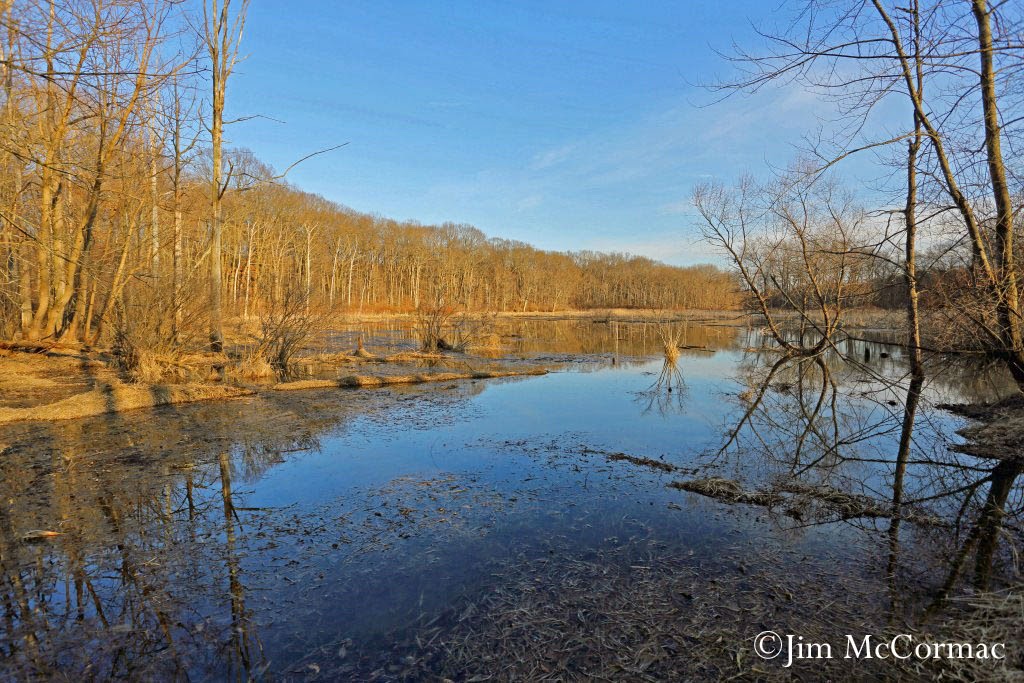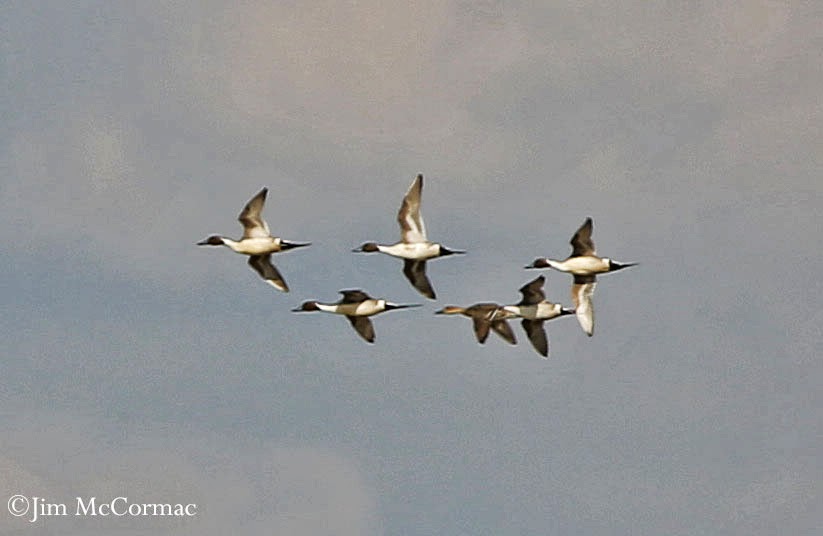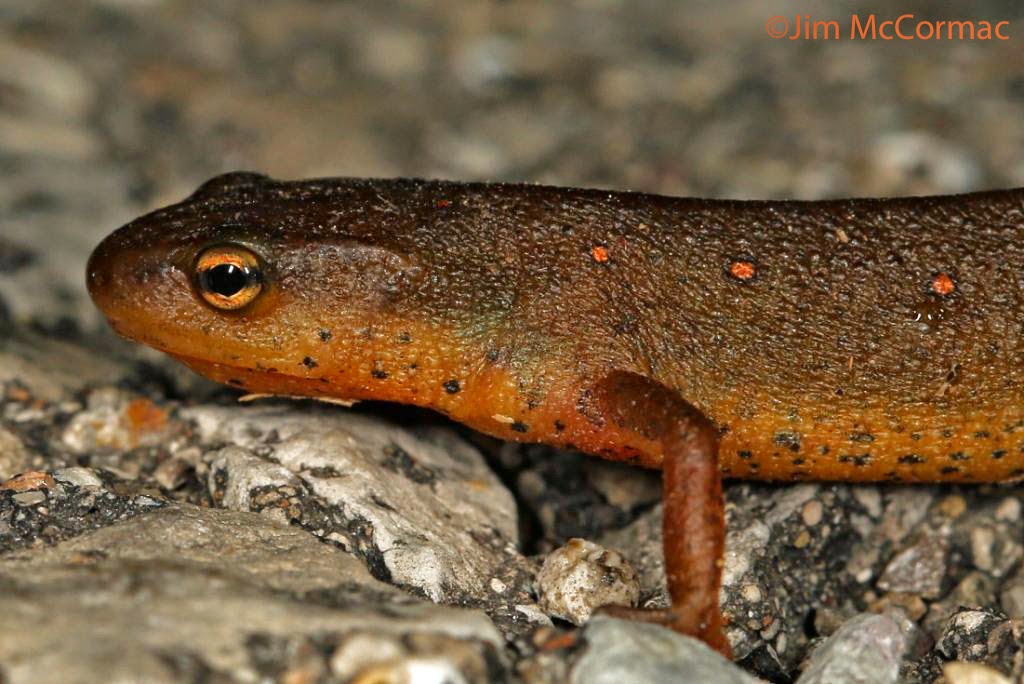This is quite literally the Mecca of waterfowling in Ohio right now. We're standing next to State Route 88, which bisects Mosquito Creek Reservoir. The vast lake is frozen solid, as is just about every other water body in the state. For some reason, currents no doubt, a freshwater polyna consistently forms under and on either side of the bridge and do the ducks and other waterfowl pack in here. The village on the reservoir's east side is named Mecca; the burg on the lake's other side is West Mecca.
Mosquito Creek is in Trumbull County, way up in the northeast corner of the state. It isn't an area I get to very often, and it's nearly a three hour drive from Columbus. I had been hearing scores of fabulous reports from this lake, and had to experience the scene firsthand. It turned out to be a 16-hour day but worth every minute. I was able to connect with a bunch of friends I don't often get afield with: Tami Gingrich, Dave Hochadel, Kristen Beck, Larry Richardson, Don Keffer and more. We had a great time, and saw lots of stuff, some of which appears in the following images.
As is the norm for a late winter/early spring Ohio day, the skies were mostly leaden and gray. I managed the photo above during the approximately 16 minutes of blue sky that we had. I would LOVE to get back here on a sunny day for more photography, but that probably won't be happening. Once the ice breaks up, the fowl will disperse. But we'll probably have another good week or so at this locale, so if you can make the Mosquito Creek scene soon, do it!
If you're into waterfowl, a scene such as this will nearly send you into cardiac arrest. There may be nothing I love more in the bird world than witnessing a big congregation of waterfowl in very early spring. Nothing pushes the vernal envelope as do the ducks. An open lead full of birds is a noisy hyperactive scene. The birds are restless, full of the drive to push north and reproduce themselves.The only thing holding them back is cold and ice. They're hot on the heels of ice-out, pushing relentlessly northward as fast as open as conditions permit.
A tiny sliver of the fowl that were present during my visit. There are five species of waterfowl in this photo, and one very aquatic member of the rail family. As always, you can click the photo to enlarge it. See if you can find and identify them all.
A squadron of Redheads prepare for landing. Birds were constantly coming in and out, making for an ever-shifting menagerie. I could have stayed, watched, and photographed all day. And I pretty much did just that.
Redheads dominate this frame; it was the most common diving duck present. Several other species can be seen: Canvasback, Bufflehead, Lesser Scaup, and American Coot. In total, we observed 22 species of ducks, geese, and swans (the coots don't count). That's over half of all the waterfowl species EVER seen in Ohio, counting the major rarities.
Onlookers were delighted when a noisy flock of Tundra Swans circled the opening. Several of the birds eventually dropped in and hung out for a while. Several of the nonnative Mute Swans were also present, and elsewhere we saw a handful of Trumpeter Swans. The Tundra Swan is our wild, highly migratory swan and this species is about as much a harbinger-of-spring as one could ask for.
A quartet of Lesser Scaup almost glow during a brief burst of sunlight. This species was fairly plentiful, but there were only a few of its doppelganger the Greater Scaup. CLICK HERE to see a photo of the latter.
A pair of drake Red-breasted Mergansers, the punk rockers of the duck world.
Huge and torpedolike, a male Common Merganser wings by. We hit the merganser trifecta, as a couple of Hooded Mergansers were also present. Common Mergansers are massive, and a well-fed one weighs three and a half pounds. Incredibly, this species is a cavity nester. Big as they are, these mergansers are fairly agile fliers to successfully thread their way into a tree hole or nest box. CLICK HERE to read the tale of Ohio's nesting population.
A trio of Common Goldeneye whistles in. And I do mean "whistle" - this species makes a loud, distinctive whistling tone with its wing feathers when in flight, and some waterfowlers refer to them as "whistlers". Like the aforementioned Common Merganser, the Common Goldeneye is also a cavity nester. Unlike the merganser, it does not nest in our state, but breeds further north. As a point of trivia, there are seven commonly occurring species of North American waterfowl (although not necessarily Ohio) that nest in cavities: Black-bellied Whistling-Duck, Wood Duck, Common Goldeneye, Barrow's Goldeneye, Bufflehead, Hooded Merganser, and Common Merganser. The species in red were present at the Mecca waters. Getting all seven of these species, with travel allowed to anywhere, on one day, would be a formidable challenge. NOTE: I am excluding the wild Muscovy, a U.S. rarity found only along the Rio Grande River in Texas.
A fleet of Common Goldeneye cavorts in the icy waters. Spring has totally sprung for this hardy species, and the males were in full courtship mode. These anatidaean clowns are quite amusing in their efforts to impress the girls. The goldeneye at far right is in the midst of his courtship display. An amorous male swims along, wagging his sizable head side to side, then suddenly throws his bill skyward and kicks his bright orange feet from the water, while emitting a comical squeaking buzz. The females act rather aloof during this energetic display, but it must work - we have plenty of goldeneyes. Ah, the things a guy must do to woo the girl... CLICK HERE for a good video of the goldeneye courtship display.
The most famous occupants of the Mosquito Creek Reservoir polyna are these Long-tailed Ducks. There were eleven of them in the house yesterday - ten drakes, and one hen. Here, the less ornate female is escorted by a phalanx of showy males. This species was once known as the "Oldsquaw", a perhaps politically incorrect nod to the males' noisy and rather incessant vocalizations. The ten birds that were here occasionally let loose with their odd howling complaints, and we could easily hear them over the rest of the fowl. Get a pack of thousands of Long-tailed Ducks together, and the din is quite impressive - they can be heard from a mile if the conditions are right.
Along with scoters and eiders, Long-tailed Ducks are sea ducks, and most spend the majority of their lives on salt water. Long-taileds are incredible divers, and if conditions call for it, they will dive 200 feet or more in search of food.
Ohio and elsewhere in the interior eastern U.S. has experienced a perhaps unrivaled influx of Long-tailed Ducks (and White-winged Scoters). I put forth a theory as to why that might be HERE.
Mosquito Creek is in Trumbull County, way up in the northeast corner of the state. It isn't an area I get to very often, and it's nearly a three hour drive from Columbus. I had been hearing scores of fabulous reports from this lake, and had to experience the scene firsthand. It turned out to be a 16-hour day but worth every minute. I was able to connect with a bunch of friends I don't often get afield with: Tami Gingrich, Dave Hochadel, Kristen Beck, Larry Richardson, Don Keffer and more. We had a great time, and saw lots of stuff, some of which appears in the following images.
As is the norm for a late winter/early spring Ohio day, the skies were mostly leaden and gray. I managed the photo above during the approximately 16 minutes of blue sky that we had. I would LOVE to get back here on a sunny day for more photography, but that probably won't be happening. Once the ice breaks up, the fowl will disperse. But we'll probably have another good week or so at this locale, so if you can make the Mosquito Creek scene soon, do it!
If you're into waterfowl, a scene such as this will nearly send you into cardiac arrest. There may be nothing I love more in the bird world than witnessing a big congregation of waterfowl in very early spring. Nothing pushes the vernal envelope as do the ducks. An open lead full of birds is a noisy hyperactive scene. The birds are restless, full of the drive to push north and reproduce themselves.The only thing holding them back is cold and ice. They're hot on the heels of ice-out, pushing relentlessly northward as fast as open as conditions permit.
A tiny sliver of the fowl that were present during my visit. There are five species of waterfowl in this photo, and one very aquatic member of the rail family. As always, you can click the photo to enlarge it. See if you can find and identify them all.
A squadron of Redheads prepare for landing. Birds were constantly coming in and out, making for an ever-shifting menagerie. I could have stayed, watched, and photographed all day. And I pretty much did just that.
Redheads dominate this frame; it was the most common diving duck present. Several other species can be seen: Canvasback, Bufflehead, Lesser Scaup, and American Coot. In total, we observed 22 species of ducks, geese, and swans (the coots don't count). That's over half of all the waterfowl species EVER seen in Ohio, counting the major rarities.
Onlookers were delighted when a noisy flock of Tundra Swans circled the opening. Several of the birds eventually dropped in and hung out for a while. Several of the nonnative Mute Swans were also present, and elsewhere we saw a handful of Trumpeter Swans. The Tundra Swan is our wild, highly migratory swan and this species is about as much a harbinger-of-spring as one could ask for.
A quartet of Lesser Scaup almost glow during a brief burst of sunlight. This species was fairly plentiful, but there were only a few of its doppelganger the Greater Scaup. CLICK HERE to see a photo of the latter.
A pair of drake Red-breasted Mergansers, the punk rockers of the duck world.
Huge and torpedolike, a male Common Merganser wings by. We hit the merganser trifecta, as a couple of Hooded Mergansers were also present. Common Mergansers are massive, and a well-fed one weighs three and a half pounds. Incredibly, this species is a cavity nester. Big as they are, these mergansers are fairly agile fliers to successfully thread their way into a tree hole or nest box. CLICK HERE to read the tale of Ohio's nesting population.
A trio of Common Goldeneye whistles in. And I do mean "whistle" - this species makes a loud, distinctive whistling tone with its wing feathers when in flight, and some waterfowlers refer to them as "whistlers". Like the aforementioned Common Merganser, the Common Goldeneye is also a cavity nester. Unlike the merganser, it does not nest in our state, but breeds further north. As a point of trivia, there are seven commonly occurring species of North American waterfowl (although not necessarily Ohio) that nest in cavities: Black-bellied Whistling-Duck, Wood Duck, Common Goldeneye, Barrow's Goldeneye, Bufflehead, Hooded Merganser, and Common Merganser. The species in red were present at the Mecca waters. Getting all seven of these species, with travel allowed to anywhere, on one day, would be a formidable challenge. NOTE: I am excluding the wild Muscovy, a U.S. rarity found only along the Rio Grande River in Texas.
A fleet of Common Goldeneye cavorts in the icy waters. Spring has totally sprung for this hardy species, and the males were in full courtship mode. These anatidaean clowns are quite amusing in their efforts to impress the girls. The goldeneye at far right is in the midst of his courtship display. An amorous male swims along, wagging his sizable head side to side, then suddenly throws his bill skyward and kicks his bright orange feet from the water, while emitting a comical squeaking buzz. The females act rather aloof during this energetic display, but it must work - we have plenty of goldeneyes. Ah, the things a guy must do to woo the girl... CLICK HERE for a good video of the goldeneye courtship display.
The most famous occupants of the Mosquito Creek Reservoir polyna are these Long-tailed Ducks. There were eleven of them in the house yesterday - ten drakes, and one hen. Here, the less ornate female is escorted by a phalanx of showy males. This species was once known as the "Oldsquaw", a perhaps politically incorrect nod to the males' noisy and rather incessant vocalizations. The ten birds that were here occasionally let loose with their odd howling complaints, and we could easily hear them over the rest of the fowl. Get a pack of thousands of Long-tailed Ducks together, and the din is quite impressive - they can be heard from a mile if the conditions are right.
Along with scoters and eiders, Long-tailed Ducks are sea ducks, and most spend the majority of their lives on salt water. Long-taileds are incredible divers, and if conditions call for it, they will dive 200 feet or more in search of food.
Ohio and elsewhere in the interior eastern U.S. has experienced a perhaps unrivaled influx of Long-tailed Ducks (and White-winged Scoters). I put forth a theory as to why that might be HERE.













































